5.11. Flow Analysis in Poland
5.11.1. Flow analysis at the Faculty of Chemistry, University of Warsaw
Marek Trojanowicz
Very high level of research and many significant achievements in various fields of analytical chemistry, first at the Faculty of Mathematics, Physics an Chemistry, and since 1955 at the Faculty of Chemistry of the University of Warsaw, from the earliest post-war years has to be attributed to a great knowledge, scientific activity and organizational ability of Professor Wiktor Kemula. One of many Kemula's revelatory and pioneering in the world scale ideas was to apply polarography for monitoring of the composition of an eluent flowing from the chromatographic column. This concept, introduced at the beginning of 1950's, was termed as "chromatopolarography" [1]. The flow analysis, considered as a methodology of physicochemical treatment of a sample in the flow mode with the use of a measurement system, arose independently from the chromatographic methods (nota bene also discovered at the University of Warsaw [2]) in the middle of 1950's and gained broad application especially in clinical and then in environmental analysis [3].
First attempts to build the measurement systems for segmented continuous flow analysis with potentiometric detection with the use of ion selective electrodes were undertaken in the middle of 1970's. The first achievements were the systems for continuous determination of nitrates and for gradient complexometric titration [4]. True innovative flow system for determination of sulphates was presented at 1st International Conference on Flow Analysis in Amsterdam in 1979 [5]. The indirect potentiometric determination with lead ion selective electrode working in galvanostatic conditions and enabling permanent activation of the electrode surface was developed. The efforts were also made to design a flow analyzer for continuous monitoring of selected components in river water and in water treatment plants for the municipal purposes. Such a multichannel analyzer, dedicated to the determination of chlorides, fluorides, nitrates and ammonia, was brought into practice in Municipal Water and Sewage Service in Warsaw [6] (see Fig. 1). At the same time a commercial multichannel flow analyzer CONTIFLO (MIM, Hungary) with photometric detection was exploited (mainly for didactic purposes) that was a replica of first models of AutoAnalyser (Technicon, USA) (see Fig. 2).
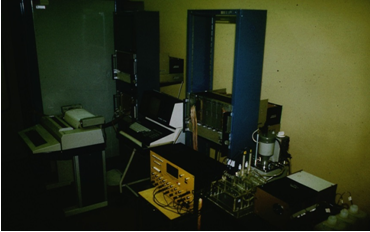
Fig.1. Multichannel flow analyzer with potentiometric detection coupled with microcomputer, for continuous and simultaneous determination of chlorides, fluorides, nitrates and ammonia in river and tap waters, designed at the Faculty of Chemistry, University of Warsaw, in 1978-80
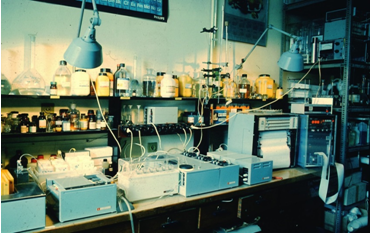
Fig. 2. Multichannel segmented flow analyzer CONTIFLO (MIM, Hangary) with photometric detection installed in 1983 at the Faculty of Chemistry, University of Warsaw, for research and didactic purposes
The examinations in the field of flow injection analysis (FIA) at the Faculty of Chemistry, University of Warsaw, were initiated in 1979 by a visit of Elo H. Hansen from Technical University of Denmark in Lyngby and then in 1981 by two-month fellowship of Marek Trojanowicz in the Jaromir Ruzicka's and Elo H. Hansen's laboratory at the same university. Impossible to overstate advices and remarks given by Elo Hansen enabled to design first potentiometric flow systems and to reveal not only advantages [7,8] but also some limitations of such measurements performed in FIA systems [9]. Within the next three years it was designed at the Faculty of Chemistry, University of Warsaw (in collaboration with a team of computer specialists and technicians) a prototype, controlled by a microprocessor FIA system with potentiometric and voltammetric detections [10] (see Fig. 3). Among its developed applications the most original seem to be those to catalytic determination of molybdenum [11] and simultaneous determination of nitrites and nitrates [12] with bioamperometric detection as well as to the computer-controlled determinations by stripping potentiometry [13].
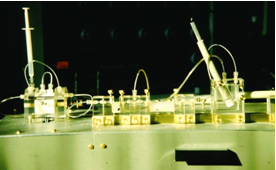
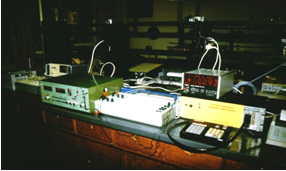
Fig. 3. Modular FIA system composed of rotary injection valve, connectors, mixing loops and cascade potentiometric detector (left) and microprocessor-controlled FIA system with voltammetric detection designed in 1986 at the Faculty of Chemistry, University of Warsaw (right)
The next steps of a great scientific novelty were very early application of optoelectronic detectors for photometric detection [14] and its adaptation for multicomponent analysis [15,16], pioneering application of unusually effective sorbents modified by complexing ligands for selective or group preconcentration in a FIA system with AAS detection [17,18], and coupling of FIA systems with high-performance chromatography [19]. Especially innovative achievements were the developments of the FIA methodology based on the multiple injection and Fourier signal transformation [20] and of the BIA (batch injection analysis) system with the sample pretreatment using solid sorbent [21].
In the late of 1980's the intensive research has been undertaken into development of electrochemical biodetection with the use of immobilized enzymes in integrated biosensors or flow microreactors. At first, an innovative amperometric biosensor was designed with enzyme immobilized in graphite paste [22]. It was a beginning of hundreds works on the paste biosensors. From among other achievements the following should be particularly mentioned: the FIA systems dedicated to simultaneous determination of glucose and ascorbic acid [23], application of potentiometric detection in sub-Nernstian range for potentiometric determination of creatinine [25], and data processing by neural network in a FIA system with amperometric detection [26].
In 1989 the Laboratory of Flow Analysis and Chromatography, headed by Marek Trojanowicz, has been founded as a separate unit of the Faculty of Chemistry, University of Warsaw. It was functioned until 2015, i.e. by M. Trojanowicz's retirement. The results accomplished by this team were more than 100 articles on flow analysis, 9 PhD theses, and more than 50 master's theses. Good measure of a great activity (and great benefits as well) of this team were cooperation's with research groups headed by Paul Worsfold from University of Hull, UK [19] (see Fig. 4),. M.E. Meyerhoff from University of Michigan, USA [24,25], P.W. Alexander and P.R. Haddad from University of New South Wales, Australia [27-29], Wolfgang Frenzel from Technical University of Berlin, Germany [13], E.A.G. Zagatto from Sao Paulo University in Piracicaba, Brazil [30], J. L. Marty from University of Perpignan, France [31,32], L. Campanella from University of Rome "La Sapienza", Italy [33], Ch. Brett from University of Coimbra, Portugal [21], J.L. Costa Lima and J. Santos from University of Porto, Portugal [34, 35], and Shoji Motomizu from Okayama University, Japan [35].
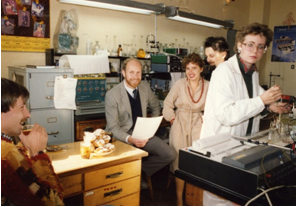
Fig. 4. Paul W. Worsfold z University of Hull, UK, visiting in 1989 to Laboratory of Flow Analysis and Chromatography at the Faculty of Chemistry, University of Warsaw. From left to right: Wojciech Matuszewski, Paul Worsfold, Joanna Szpunar, Tadeusz Krawczynski Pavel Krawczyk, Ewa Pobozy.
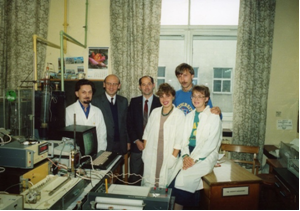
Fig. 5. George Horvai from Technical University of Budapest, Hungary, visiting in 1990 to Laboratory of Flow Analysis and Chromatography at the Faculty of Chemistry, University of Warsaw. From left to right: Tadeusz Krawczy?ski vel Krawczyk, Marek Trojanowicz, George Horvai, Joanna Szpunar, Wojciech Ma-tuszewski, Ewa Pobozy.
In the late of 1990's very effective and fruitful activity in the field of flow injection analysis was initiated at the Faculty of Chemistry, University of Warsaw, by a Robert Koncki's team. First efforts concerned development of ion selective electrodes modified by monomolecular enzyme layers and operated in the flow conditions. The biosensors have been applied to the determination of ?-lactam antibiotics in pharmaceutical samples and to the control of biotechnological process of penicillin production in Polfa pharmaceutical factory [36].Biosensors with immobilized urease were successfully used for analysis of pharmaceutical products and of urine and serum [37]. Biosensors sensitive to urea and creatinine, installed into dedicated flow systems, were applied to monitoring of the hemodialysis process [38]. Other articles were related to the potentiometric (fluorometric and pH-metric) electrodes applied in dedicated flow systems to the measurement of the alkaline phosphatase activity [40] as well as to the determination of alkaline phosphatase [40] and its inhibitors [41].
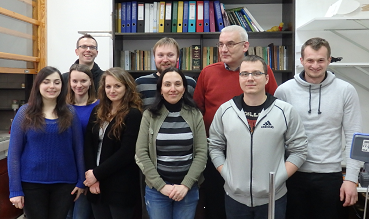
Fig. 6. Robert Koncki's team; from left to right in the first row: Natalia Rybkowska, Marta Fiedoruk-Pogrebniak, Justyna Bzura, Marta Pokrzywnicka, Kamil Strzelak, Mateusz Granica; in the second row: Lukasz Tymecki, Michal Michalec, Robert Koncki
At present, the Koncki's group is involved mainly in development flow optical detectors, sensors and biosensors. First investigations were related to optical flow-through biosensor based on Prussian Blue (PB) film [42]; it was revealed that PB enables optical detection of both pH and selected oxidizing and reducing agents; hence the PB films modified by different enzymes can be used for the determination of urine and glucose in various real samples. For several years the team is also strongly interested in flow optoelectronic micro detectors, such as paired emitter detector diodes (PEDD), and in their applications in the multicommutated flow systems for purposes mainly of clinical and biomedical diagnostics. These are the detectors dedicated to photometric [43] and fluorometric [44], as well as nephelometric and turbidimetric [45] determinations. The flow systems have been developed for determination of selected ions [46], metabolites [47], proteins, antibodies, and enzymes in physiological fluids. The analyses are important for clinical diagnosis of cancer and urinary diseases [48]. In collaboration with Victor Cerda's and Manuel Miro's groups (University of the Balearic Islands, Palma de Mallorca) it was confirmed that the developed PEDD detectors [49] sensors and biosensors [50] can be also successfully incorporated into the SIA systems.
The scientific results of the Koncki's team are ca. 50 articles in prestigious journals and 9 PhD theses defended in the flow analysis area.









